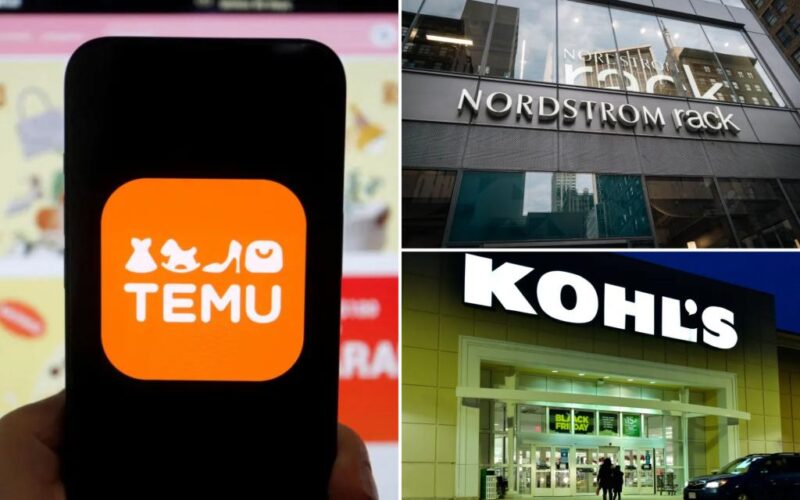Shoppers have fled Temu and Shein after President Trump slapped the Chinese sites with hefty tariffs – spending their dollars instead at US department stores like Nordstrom Rack and Kohl’s, according to data exclusively shared with The Post.
Temu saw its spending growth among US customers plummet in April, slowing from nearly 50% year-over-year growth at the start of the month to nearly 0% at the end, according to credit and debit card data analyzed by Consumer Edge.
Shein also suffered a steep decline in US spending growth, cooling from 30% at the start of April to just 20% at the end.
That spending slowdown is no coincidence.
In early April, Trump ended the de minimis exemption, a trade loophole that both Temu and Shein used to avoid paying taxes while sending low-value packages to the US.
They were hit with a 120% tariff overnight, forcing the retailers to hike prices and halt shipments of Chinese products. The White House lowered that rate to 54% on Tuesday.
In the three weeks ended April 27, former Temu and Shein shoppers spent 21% more at Nordstrom Rack than the year before, according to Consumer Edge. That’s more than the 12% overall spend growth at Nordstrom Rack.
“It could be that these folks have been shopping at department stores for a while, were attracted to affordable prices from Temu and Shein, and then became a little cold on those brands amid everything going on,” Michael Gunther, vice president and head of insights at Consumer Edge, told The Post.
Former Temu and Shein shoppers – who made multiple purchases at the Chinese sites earlier in the year but none in March or April – brought their business to Bloomingdale’s, Old Navy and Kohl’s over the same three weeks, according to Consumer Edge.
They spent 52%, 12% and 6% more at these retailers than the year before, outpacing overall spending growth from all customers, according to the data.
Much like Temu and Shein, department stores are a one-stop shop – selling apparel, footwear, beauty products, furniture and kitchen appliances.
“There’s a huge selection, lot of different brands, lot of different types of products in one place,” Gunther told The Post. “Maybe it’s that sort of thing that’s similar to the mindset of someone who might have been shopping at Temu before.”
Along with department stores, these shoppers’ appetite for a good deal led them to spend more on fashion subscription services, which rent out high-end clothing at discounted prices.
Former Temu and Shein customers spent 59% more at Nuuly, an apparel subscription service owned by the same firm as Anthropologie.
They increased their purchases at thrift stores, as well, spending 45% more at second-hand retail chain Savers.
That spending trend “really speaks to not just the wide selections available on these sites, similar to Temu and Shein, but also people looking to purchase on a budget,” Gunther told The Post.
“You want a wide-ranging, diverse wardrobe, but you don’t want to spend too much. This is a way to do that,” he added.
There’s also been a 42% spending surge by these customers at DHgate.com, which connects shoppers with Chinese wholesalers. Chinese wholesale suppliers have taken to TikTok to advertise highly-discounted goods to US shoppers.
It’s unclear whether the shift away from Temu and Shein will continue. It depends largely on how consumer sentiment fares over the next few weeks and whether the 54% tariff remains in place, Gunther said.
And the White House’s 30% tariff on Chinese goods – temporarily lowered from 145% for 90 days – could send prices soaring for US retailers selling clothing manufactured overseas, make department stores less attractive.








